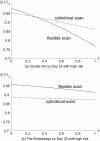A flexibly shaped space-time scan statistic for disease outbreak detection and monitoring
- PMID: 18402711
- PMCID: PMC2386448
- DOI: 10.1186/1476-072X-7-14
A flexibly shaped space-time scan statistic for disease outbreak detection and monitoring
Abstract
Background: Early detection of disease outbreaks enables public health officials to implement disease control and prevention measures at the earliest possible time. A time periodic geographical disease surveillance system based on a cylindrical space-time scan statistic has been used extensively for disease surveillance along with the SaTScan software. In the purely spatial setting, many different methods have been proposed to detect spatial disease clusters. In particular, some spatial scan statistics are aimed at detecting irregularly shaped clusters which may not be detected by the circular spatial scan statistic.
Results: Based on the flexible purely spatial scan statistic, we propose a flexibly shaped space-time scan statistic for early detection of disease outbreaks. The performance of the proposed space-time scan statistic is compared with that of the cylindrical scan statistic using benchmark data. In order to compare their performances, we have developed a space-time power distribution by extending the purely spatial bivariate power distribution. Daily syndromic surveillance data in Massachusetts, USA, are used to illustrate the proposed test statistic.
Conclusion: The flexible space-time scan statistic is well suited for detecting and monitoring disease outbreaks in irregularly shaped areas.
Figures



Similar articles
-
A flexible spatial scan statistic with a restricted likelihood ratio for detecting disease clusters.Stat Med. 2012 Dec 30;31(30):4207-18. doi: 10.1002/sim.5478. Epub 2012 Jul 16. Stat Med. 2012. PMID: 22807146
-
Benchmark data and power calculations for evaluating disease outbreak detection methods.MMWR Suppl. 2004 Sep 24;53:144-51. MMWR Suppl. 2004. PMID: 15714644
-
A space-time scan statistic for detecting emerging outbreaks.Biometrics. 2011 Mar;67(1):106-15. doi: 10.1111/j.1541-0420.2010.01412.x. Biometrics. 2011. PMID: 20374242
-
Identifying areas for infectious animal disease surveillance in the absence of population data: highly pathogenic avian influenza in wild bird populations of Europe.Prev Vet Med. 2010 Aug 1;96(1-2):1-8. doi: 10.1016/j.prevetmed.2010.05.002. Prev Vet Med. 2010. PMID: 20537421 Review.
-
Review of methods for space-time disease surveillance.Spat Spatiotemporal Epidemiol. 2010 Jul;1(2-3):105-16. doi: 10.1016/j.sste.2009.12.001. Epub 2010 Feb 20. Spat Spatiotemporal Epidemiol. 2010. PMID: 22749467 Free PMC article. Review.
Cited by
-
Monitoring European data with prospective space-time scan statistics: predicting and evaluating emerging clusters of COVID-19 in European countries.BMC Public Health. 2022 Nov 25;22(1):2183. doi: 10.1186/s12889-022-14298-z. BMC Public Health. 2022. PMID: 36434572 Free PMC article.
-
Suitability and limitations of portion-specific abattoir data as part of an early warning system for emerging diseases of swine in Ontario.BMC Vet Res. 2012 Jan 6;8:3. doi: 10.1186/1746-6148-8-3. BMC Vet Res. 2012. PMID: 22225910 Free PMC article.
-
Disparities in Temporal and Geographic Patterns of Myocardial Infarction Hospitalization Risks in Florida.Int J Environ Res Public Health. 2019 Nov 27;16(23):4734. doi: 10.3390/ijerph16234734. Int J Environ Res Public Health. 2019. PMID: 31783516 Free PMC article.
-
A semiparametric cluster detection method--a comprehensive power comparison with Kulldorff's method.Int J Health Geogr. 2009 Dec 31;8:73. doi: 10.1186/1476-072X-8-73. Int J Health Geogr. 2009. PMID: 20043837 Free PMC article.
-
Maximum linkage space-time permutation scan statistics for disease outbreak detection.Int J Health Geogr. 2014 Jun 10;13:20. doi: 10.1186/1476-072X-13-20. Int J Health Geogr. 2014. PMID: 24916839 Free PMC article.
References
-
- Heffernan R, Mostashari F, Das D, Karpati A, Kulldorff M, Weiss D. Syndromic surveillance in public health practice, New York City. Emerging Infectious Diseases. 2004;10:858–864. - PubMed
-
- Platt R, Bocchino C, Caldwell B, Harmon R, Kleinman K, Lazarus R, Nelson AF, Nordin JD, Ritzwoller P. Syndromic surveillance using minimum transfer of identifiable data: the example of the National Bioterrorism Syndromic Surveilance Demonstration Program. Journal of Urban Health. 2003;80:i25–i31. - PMC - PubMed
-
- Sonesson C, Bock D. A review and discussion of prospective statistical surveillance in public health. Journal of the Royal Statistical Society, Series A. 2003;166:5–21.
Publication types
MeSH terms
Grants and funding
LinkOut - more resources
Full Text Sources

